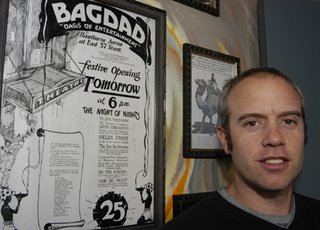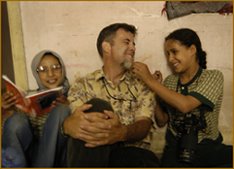Making A Killing

When most documentary filmmakers offer to shoot their subjects, they usually mean with a camera, cinematically. But Mike Shiley--whose film Inside Iraq: The Untold Stories has been touring college campuses and independent cinemas in the U.S.--thought it would be vastly more interesting to do it with a gun, literally.
Shiley’s largely autobiographical film describes how he replaced a tank gunner on a U.S. Army “harass-and-intimidate” mission on Iraq’s northwestern border. During the operation, Shiley fired an M1A1-Abrams tank’s main gun down what he describes as a “dry riverbed” in the village of Al Qaim to show residents that “Americans own the town.”
Two Iraqi homes were set afire during the exercise, Shiley states in the 95-minute video.
Gary D. Solis, professor of law at the U.S. Military Academy at West Point, argues that Shiley’s actions likely violated the Geneva Convention and that Shiley “should be prosecuted” in federal court for war crimes in Iraq.
Shiley, based in Portland, says he cashed in frequent-flier miles in December of 2003 and bought an airline ticket to Amman, Jordan, on his way to Baghdad. He secured press credentials from Portland’s KATU-TV, an ABC News affiliate, and used them to “sneak” into Iraq in December of 2003, he says.
After touring a number of Iraqi cities, Shiley then embedded with the U.S. Army’s 3rd Armored Cavalry Regiment, based near Al Qaim, roughly five miles from the Syrian border. After Shiley obtaining permission for a ride-along on a combat patrol, the tank commander told Shiley he’d have to sit in the bottom of the vehicle.
“I couldn’t even see,” Shiley laments. The gunner’s position, he felt, afforded the best view for filming. Over footage that depicts himself in a U.S. Army uniform, firing a machine gun over a desert wasteland, Shiley says the tank commander told him he would first “have to become weapons certified” if he wanted to replace the trained gunner.
“I said, ‘Great! Let’s get started!’”
The video segues to footage of two Bradley Fighting Vehicles and two Abrams tanks converging on Al Qaim in darkness. They line up in tandem on a deserted city street. The walls of two-story homes rise less than 100 feet from the vehicles as the Abram’s main guns open up.
“It’s meant to wake up the residents of the town,” Shiley’s voice-over explains, “to let them know these guns are loaded, they work, and the U.S. Army is not to be messed with.”
The film switches to an interior view of Shiley loading a heavy shell into the Abrams’ main gun. He takes the gunner’s seat, timidly squeezes the trigger. The tank shudders. Shiley sighs deeply, shakes his head, erupts in laughter. He gives viewers the thumbs up. “It’s an amazing testosterone rush,” he explains.
Shiley says the patrol then fired smoke grenades into the village to conceal its exit. “It was a pretty amazing experience, and I noticed that after we dropped the smoke grenades, that a number of those didn’t burn out like the way they were supposed to, and actually, I noticed two houses that caught on fire as we were pulling out of there that night. I guess that’s one of the casualties of war. And I certainly hope that that fire was put out.”
Shiley filed a sanitized version of how he came to be involved in the Al Qaim operation on his KATU-TV “weblog.” On Jan. 12, 2004, Shiley wrote, “After a brief lesson from Sergeant [Johnny] Shaw, I successfully loaded and fired the M-240. When I squeezed the trigger, the machine gun burst to life, sending a shower of bullets and red tracers streaking through the night sky. I assured Shaw that even though I was a reporter, I was ready, willing, and able to defend the mission if he gave the command to engage the enemy.”
The weblog also offered a sanitized version of the “harass and intimidate” patrol. “We rolled back to Tiger base dirty and tired,” Shiley wrote, “but filled with the satisfaction of a job done right. The team worked together to accomplish a dangerous mission knowing that an attack was imminent. Each soldier performed his or her task with professional calmness and focus on the objective.
"Tonight the innocent people of Al Qaim will sleep well knowing that their new freedom will be protected. As for the bad guys … their ears are still ringing from the sound of a gun called American Justice.”
No mention was made of the burning homes.
Solis, who says he founded the “law of war” course at West Point, argues that Shiley’s actions “expose the tank commander to trial by court-martial” and expose Shiley to federal prosecution for war crimes.
“Civilians are not permitted to crew combat vehicles--period,” says Solis, former chief of the U.S. Marine Corps Military Law Branch at the Pentagon. “There are no exceptions and there is no such thing as a civilian being ‘certified’ as a tank crewman. It is contrary to military regulations and, more significantly, it is a violation of the law of armed conflict.”
Shiley cannot be absolved of wrongdoing, Solis argues, by virtue of the fact that U.S. troops were not under enemy fire. “It is not necessary that there be a ‘fight’ in the sense of return fire, or even a visible enemy. When he fired a weapon he put himself beyond the law of war and probably federal law as well.”
In a Feb. 15 interview, Shiley said he was “not 100 percent sure” that no Iraqis were killed but he is, however, “completely confident.” The tank commander, according to Shiley, used an infrared imaging scope to ensure no Iraqis were present in the field of fire. “I let the tank commander do the aiming. All I did was push the button. If I’m going to sign up and play soldier for a day, that’s unfortunately one of the liabilities that I have to accept--that my actions may injure or kill somebody.”
Shiley says he cannot be held accountable, due to the fact that his tank was the last to fire down the riverbed. “The Bradley’s and two other tanks had already fired their weapons, so anything that might have been alive was surely dead by the time it was my turn to fire.”
Also disturbing is potentially faked footage that depicts a Kurdish man removing a landmine alongside a highway near Kirkuk. The Kurd, a landmine-removal worker for the Mines Advisory Group, based in Manchester, U.K., brushes away a few weeds from the surface of an anti-tank mine. Although the implication is that the device is live--has just been unearthed--the mine is spotless. A trench in the hardpan soil, several inches deep, already runs the perimeter. The Kurd carefully loops a rope around the mine and moves off a respectable distance before tightening the line.
“As this guy’s pulling the landmine out of the hole,” Shiley relates in the sardonic voice-over, “I’m there like a dummy, getting a close-up shot of this landmine being pulled out. While he’s 30 feet away, I’m five feet away. It was not one of the smarter decisions I’ve made in my life.”
Why did Shiley brave the excavation, while the landmine worker took cover? Because, according to the Kurdish mine experts present at the time, the device was a dud, planted for Shiley’s benefit. “The scene was a re-enactment with a training mine,” says David Horrocks, director of field operations for the Mines Advisory Group in Iraq. After viewing Shiley's film, Horrocks contacted the workers and confirmed that at Shiley's request, a dummy mine had been in the pit for a "demonstration" of how live mines are excavated.
Shiley claims that none of the Kurdish landmine experts spoke English, that he had to communicate in “hand gestures,” and, therefore believed the mine "was live." He also states that his video mike failed, the batteries died in his portable mike, and "high winds" prevented him from recording live sound to verify his claim.
The Kurdish mine expert, however, “spoke excellent English,” according to Joe DiCarlo, who was present for the staged event. “The MAG guy said, ‘Let us show you our practice area,’” explains DiCarlo, director of emergency relief for Northwest Medical Teams, a humanitarian-aid organization based in Portland.
Irena Kuszta, communications director for the landmine group, says, “Either Shiley did not understand English on the day he was filming, or he knowingly misrepresented what he was filming.”
Kuszta says the humanitarian organization asked Shiley in March to correct the footage, but Shiley declined.
“We have asked for him to readdress the balance and state the truth of the situation,” Kuszta notes, “but he insists this was not a balanced version of events, but a story of an ordinary person in the field.”
What matters most, Shiley insists, is motivation. “I made this film because I care,” he remarks in the film’s opening sequence. “I truly care about what happens in the world, and I hope you care too.”
The film’s executive producer, Rick Ray, shrugs off the possibility that Shiley’s actions, or his work as the film's executive producer, might invite criticism. “History is full of examples of films that took a hit from critics, and it only boosted their sales,” says Ray, an instructor at the Brooks Institute of Photography in Santa Barbara, Calif.
“If this turns out to be this big controversy,” Shiley adds, “I’m going to write an editorial, and I’m coming right back to Portland and put this film back in the theaters and we’re going to make a killing.”
Additional Resources: Website for Inside Iraq: http://www.insideiraqthemovie.com/
Mines Advisory Group: http://www.mag.org.uk/
Note: After a shorter version of this article appeared in the Arab American News, published in Dearborn, Mich., KATU-TV removed Shiley's weblog from its website.


1 Comments:
Where did the comments go?
Post a Comment
<< Home